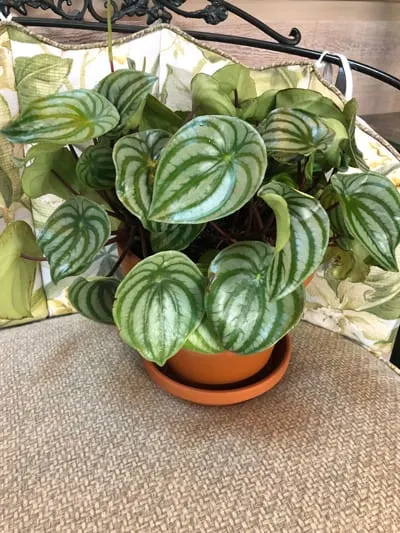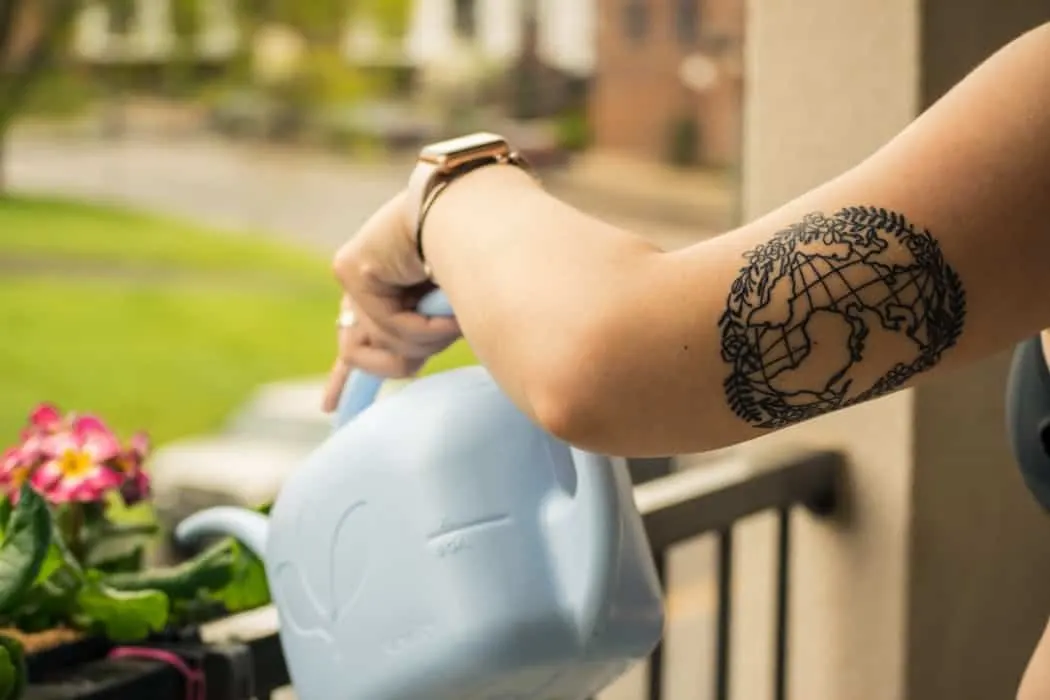Some of the links in this post may be affiliate links.
People are generally very confused over how to water houseplants properly. The problem is that it is easy to misinterpret a lot of aspects about houseplant care in general.
This post focuses on one aspect of houseplant care, and that is to help you understand everything about watering your houseplant properly.
Here are a few watering myths that I’ve come across that I would like to debunk.
Table of Contents
Myth #1: I shouldn’t soak my succulents. They only need a little bit of water at a time.
WRONG! Almost without exception, I recommend thoroughly soaking your houseplant, regardless of whether it is a succulent or not.
And no I’m not crazy. It works and I speak from experience, so trust me!
Keep reading though…because you might be wondering “oh I thought succulents don’t like much water?” Well that’s only partially true.

If you just add a little bit of water (because succulents don’t need that much water, right?), you are doing a big disservice to your plant.
If you don’t thoroughly soak your plant and just add a little bit of water, you are encouraging a shallow root system. And if you have a poor and shallow root system, your whole plant will suffer. Without a healthy root system, you will not have a healthy plant.
Yes it is true that succulents don’t need as much water as many tropical foliage plants, however, you should still soak your plant.
The critical part for succulents is that after you water, you should wait long enough for the potting soil to pretty much go completely dry before watering again. And when you do water again, soak it again!
Let the water drain through the drainage hole and discard any extra water. Less frequent, but thorough-watering, is superior to frequent mini-drinks of water.
Myth #2: Houseplants Need to Be Watered Once a Week
WRONG! Well, the real answer is that it depends! In some cases, yes this may work! But only under certain combinations of conditions.
It’s ok to have a regular checkpoint to see if your houseplants need water or not, but you shouldn’t blindly water a houseplant just because your schedule tells you to.
If you watered a plant, and a week later the top of the soil is still moist, you should NOT water it again. Doing so will invite root-rot.

When a plant stays too wet, you are depriving the roots of oxygen and they will proceed to rot. As a general rule of thumb, you should wait to water until the top inch or two of the soil is dry (depending on the size of the pot).
Then go ahead and give it a good soaking. There are some exceptions though. Some plants, such as succulents or cacti, should be allowed to go completely dry before watering again…but don’t wait TOO long!
The concept of “overwatering” houseplants is very rampant and it doesn’t necessarily mean what you think! Check out my blog post on overwatering and find out what it really means.
Myth #3: You Water Orchids with Ice
NO! Unless you’ve seen a monkey with a popsicle in the jungle, then you should not water your orchids with ice. This is one of the worst marketing gimmicks I’ve ever seen.
Do NOT use ice to water your orchids. First of all, when the ice melts, it does not provide enough water in order to soak the potting medium and thoroughly moisten all the orchid roots.

Secondly, the ice can damage the roots if they come into direct contact with the ice. It makes absolutely zero sense to water orchids with ice.
This scheme is mainly marketed for Phalaenopsis or moth orchids. Phalaenopsis come from the tropics of southeast Asia and I guarantee you they’ve never met an ice cube.
To read more details on why you shouldn’t use ice cubes, be sure not to miss my 5 Reasons Why You Should NOT Water Orchid With Ice Cubes blog post.
Myth #4: If I fuss over my houseplants, they’ll grow better
Don’t get too happy with that watering can! You have to let nature take its course and a lot of people tend to overwater their houseplants.
Like I mentioned, it’s OK to have a regular checkpoint to see if your plants need water, but don’t water just because you told yourself you need to water every Saturday.
I can’t emphasize the following point enough: If your calendar is telling you that it’s your normal watering time, and you feel the surface of the soil and it is still moist, then don’t water!

On the other hand, you might find a houseplant that dried out terribly and once a week may not be enough. You may need a couple checkpoints during the week.
Why is this? Watering needs vary drastically depending on:
Temperature: Higher temperatures means that soil will dry out more quickly.
Pot Size: Smaller pots will dry out much more quickly.
Pot Material: Terra cotta pots will dry out very quickly because they are porous. Plastic or glazed ceramic pots will take longer to dry out.
Choosing a pot type based off of your specific plant can work to your advantage or disadvantage, so choose carefully depending on the moisture needs of your plant.
Growing Season: Depending on where you live, plants will slow down or stop growing in the middle of a dark/cold winter.
So they will not use as much water and you have to be careful not to “overwater” especially during this time. On the other hand, during the growing season, plants will use more water.
Root System Size: Recently I was shocked because I had watered my large hibiscus tree indoors in the middle of winter, and 3-4 days later, it was very dry.
This plant has an extensive root system and is in a large pot. I probably won’t be repotting that plant anymore otherwise it’ll be too difficult to move.
Having a pot-bound plant, coupled with increasing growth as days are getting longer, all increase the need for watering.
Humidity: In a more humid atmosphere, soil will generally take longer to dry.
Light Levels: The higher the light levels, the more water a plant will use. A plant that is sitting in a dark corner will use much less water than a plant that is in brighter light that is actively photosynthesizing and growing.
Myth #5: Everything on the internet is true
WRONG! This one is a BIG WRONG. You can tell the websites that just regurgitate material versus those that truly have knowledge to back it up.
Be weary of any old website, or many sources on social media, when getting houseplant care information especially when it seems vague and generalized.
I’ve seen so much misinformation online. So if you are researching online, trust reputable sources (such as Ohio Tropics!) Or if you have very specific questions, it is best to refer to the numerous plant societies out there such as:
So there you have it! Hopefully you have taken away some helpful pointers in houseplant watering. Did you read anything here that was new information for you? If so, comment below!







Barbara
Saturday 4th of November 2023
I love this article. My house plants thank you.
Raffaele
Monday 6th of November 2023
Glad you enjoyed the article Barbara! :-)
Connie Rivera
Tuesday 10th of October 2023
I was aware of most of the information, but your article was very clear (easy to read and simple, to-the-point advice, i.e. no rambling with useless words.) I loved it! Also, I found the info on watering succulents VERY useful! Thank you!
Raffaele
Tuesday 10th of October 2023
So glad that you enjoyed it Connie! Thanks for taking the time to let me know :-)
Angela Marable
Thursday 15th of June 2023
I am growing milkweed and pathos and the bulbs of a onion plant that pop up out of nowhere but I like it’s look so I’m trying to be very careful. How many times should I water pathos and milkweed?
Raffaele
Monday 19th of June 2023
Hi Angela! I would let the top inch or so of the soil dry out and then water. Frequency varies because all of our growing conditions are different. Just use your finger to judge the soil moisture and water when the top inch feels dry.
Jo-Anne Lemaire
Wednesday 5th of October 2022
Raffaele, Thank you for your first 'how to water houseplants' newsletter. Very informative. :)
Suzy
Friday 9th of September 2022
Dear Raffaele, I have a hibiscus about 4' tall that my daughter gave me and I adore it. After I got it about a year ago it got the most beautiful flowers. Then it started getting yellow leaves and other signs something was wrong. There sure was it was fungus. I think it got it from a pot I transplanted it to. Well I have sprayed it with funguscide, but found out the thing that has helped the most was to a add peroxide to the water when I water it. It is getting new leaves but there aren't many but it is trying to come back. Will I be able to save it or should I give up hope?
Raffaele
Friday 9th of September 2022
I wouldn't give up hope yet. I have 3 blog posts on hibiscus that may help you: https://www.ohiotropics.com/2021/07/27/hibiscus-dying-not-blooming/ https://www.ohiotropics.com/2022/06/16/how-to-get-hibiscus-to-bloom/ https://www.ohiotropics.com/2022/07/28/overwintering-hibiscus/